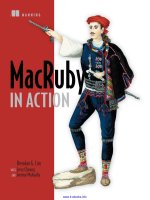linq in action
Bạn đang xem bản rút gọn của tài liệu. Xem và tải ngay bản đầy đủ của tài liệu tại đây (11.78 MB, 572 trang )
www.it-ebooks.info
LINQ in Action
www.it-ebooks.info
www.it-ebooks.info
LINQ in Action
FABRICE MARGUERIE
STEVE EICHERT
JIM WOOLEY
MANNING
Greenwich
(74° w. long.)
www.it-ebooks.info
For online information and ordering of this and other Manning books, please visit
www.manning.com. The publisher offers discounts on this book when ordered in quantity.
For more information, please contact:
Special Sales Department
Manning Publications Co.
Sound View Court 3B fax: (609) 877-8256
Greenwich, CT 06830 email:
©2008 by Manning Publications Co. All rights reserved.
No part of this publication may be reproduced, stored in a retrieval system, or transmitted, in
any form or by means electronic, mechanical, photocopying, or otherwise, without prior written
permission of the publisher.
Many of the designations used by manufacturers and sellers to distinguish their products are
claimed as trademarks. Where those designations appear in the book, and Manning
Publications was aware of a trademark claim, the designations have been printed in initial caps
or all caps.
Recognizing the importance of preserving what has been written, it is Manning’s policy to have
the books we publish printed on acid-free paper, and we exert our best efforts to that end.
Recognizing also our responsibility to conserve the resources of our planet, Manning books are
printed on paper that is at least 15% recycled and processed without the use of elemental chlorine.
Manning Publications Co. Copyeditor: Benjamin Berg
Sound View Court 3B Typesetter: Gordan Salinovic
Greenwich, CT 06830 Cover designer: Leslie Haimes
ISBN 1-933988-16-9
Printed in the United States of America
12345678910–MAL –131211100908
www.it-ebooks.info
v
brief contents
PART 1GETTING STARTED 1
1 ■ Introducing LINQ 3
2
■ C# and VB.NET language enhancements 44
3
■ LINQ building blocks 82
PART 2QUERYING OBJECTS IN MEMORY 113
4 ■ Getting familiar with LINQ to Objects 115
5
■ Beyond basic in-memory queries 160
PART 3QUERYING RELATIONAL DATA 203
6 ■ Getting started with LINQ to SQL 205
7
■ Peeking under the covers of LINQ to SQL 237
8
■ Advanced LINQ to SQL features 267
PART 4MANIPULATING XML 311
9 ■ Introducing LINQ to XML 313
10
■ Query and transform XML with LINQ to XML 350
11
■ Common LINQ to XML scenarios 385
www.it-ebooks.info
vi BRIEF CONTENTS
PART 5LINQING IT ALL TOGETHER 435
12 ■ Extending LINQ 437
13
■ LINQ in every layer 482
www.it-ebooks.info
vii
contents
foreword xv
preface xvii
acknowledgments xix
about this book xxii
PART 1GETTING STARTED 1
1
Introducing LINQ 3
1.1 What is LINQ? 4
Overview 5
■
LINQ as a toolset 6
■
LINQ as language
extensions 7
1.2 Why do we need LINQ? 9
Common problems 10
■
Addressing a paradigm mismatch 12
LINQ to the rescue 18
1.3 Design goals and origins of LINQ 19
The goals of the LINQ project 20
■
A bit of history 21
1.4 First steps with LINQ to Objects: Querying collections
in memory 23
What you need to get started 23
■
Hello LINQ to Objects 25
www.it-ebooks.info
viii CONTENTS
1.5 First steps with LINQ to XML: Querying XML
documents 29
Why we need LINQ to XML 30
■
Hello LINQ to XML 32
1.6 First steps with LINQ to SQL: Querying relational
databases 37
Overview of LINQ to SQL’s features 37
■
Hello LINQ to
SQL 38
■
A closer look at LINQ to SQL 42
1.7 Summary 42
2
C# and VB.NET language enhancements 44
2.1 Discovering the new language enhancements 45
Generating a list of running processes 46
■
Grouping results
into a class 47
2.2 Implicitly typed local variables 49
Syntax 49
■
Improving our example using implicitly
typed local variables 50
2.3 Object and collection initializers 52
The need for object initializers 52
■
Collection initializers 53
Improving our example using an object initializer 54
2.4 Lambda expressions 55
A refresher on delegates 56
■
Anonymous
methods 58
■
Introducing lambda expressions 58
2.5 Extension methods 64
Creating a sample extension method 64
■
More
examples using LINQ’s standard query operators 68
Extension methods in action in our example 70
Warnings 71
2.6 Anonymous types 73
Using anonymous types to group data into an object 74
Types without names, but types nonetheless 74
Improving our example using anonymous
types 76
■
Limitations 76
2.7 Summary 79
www.it-ebooks.info
CONTENTS ix
3
LINQ building blocks 82
3.1 How LINQ extends .NET 83
Refresher on the language extensions 83
■
The key elements
of the LINQ foundation 85
3.2 Introducing sequences 85
IEnumerable<T> 86
■
Refresher on iterators 87
Deferred query execution 89
3.3 Introducing query operators 93
What makes a query operator? 93
■
The standard query
operators 96
3.4 Introducing query expressions 97
What is a query expression? 98
■
Writing query
expressions 98
■
How the standard query operators relate
to query expressions 100
■
Limitations 102
3.5 Introducing expression trees 104
Return of the lambda expressions 105
■
What are
expression trees? 105
■
IQueryable, deferred query
execution redux 108
3.6 LINQ DLLs and namespaces 109
3.7 Summary 111
PART 2QUERYING OBJECTS IN MEMORY 113
4
Getting familiar with LINQ to Objects 115
4.1 Introducing our running example 116
Goals 116
■
Features 117
■
The business entities 117
Database schema 118
■
Sample data 118
4.2 Using LINQ with in-memory collections 121
What can we query? 121
■
Supported operations 126
4.3 Using LINQ with ASP.NET and Windows Forms 126
Data binding for web applications 127
■
Data binding
for Windows Forms applications 133
www.it-ebooks.info
x CONTENTS
4.4 Focus on major standard query operators 137
Where, the restriction operator 138
■
Using projection
operators 139
■
Using Distinct 142
■
Using conversion
operators 143
■
Using aggregate operators 145
4.5 Creating views on an object graph in memory 146
Sorting 146
■
Nested queries 147
■
Grouping 150
Using joins 151
■
Partitioning 155
4.6 Summary 159
5
Beyond basic in-memory queries 160
5.1 Common scenarios 161
Querying nongeneric collections 162
■
Grouping by multiple
criteria 164
■
Dynamic queries 167
■
LINQ to Text Files 178
5.2 Design patterns 180
The Functional Construction pattern 181
■
The ForEach
pattern 184
5.3 Performance considerations 186
Favor a streaming approach 187
■
Be careful about immediate
execution 189
■
Will LINQ to Objects hurt the performance of my
code? 191
■
Getting an idea about the overhead of LINQ to
Objects 195
■
Performance versus conciseness: A cruel
dilemma? 198
5.4 Summary 200
PART 3QUERYING RELATIONAL DATA 203
6
Getting started with LINQ to SQL 205
6.1 Jump into LINQ to SQL 207
Setting up the object mapping 209
■
Setting up the
DataContext 212
6.2 Reading data with LINQ to SQL 212
6.3 Refining our queries 217
Filtering 217
■
Sorting and grouping 219
Aggregation 221
■
Joining 222
www.it-ebooks.info
CONTENTS xi
6.4 Working with object trees 226
6.5 When is my data loaded and why does it matter? 229
Lazy loading 229
■
Loading details immediately 231
6.6 Updating data 233
6.7 Summary 236
7
Peeking under the covers of LINQ to SQL 237
7.1 Mapping objects to relational data 238
Using inline attributes 239
■
Mapping with external XML
files 245
■
Using the SqlMetal tool 247
■
The LINQ to SQL
Designer 249
7.2 Translating query expressions to SQL 252
IQueryable 252
■
Expression trees 254
7.3 The entity life cycle 257
Tracking changes 259
■
Submitting changes 260
Working with disconnected data 263
7.4 Summary 266
8
Advanced LINQ to SQL features 267
8.1 Handling simultaneous changes 268
Pessimistic concurrency 268
■
Optimistic concurrency 269
Handling concurrency exceptions 272
■
Resolving conflicts using
transactions 276
8.2 Advanced database capabilities 278
SQL pass-through: Returning objects from SQL queries 278
Working with stored procedures 280
■
User-defined
functions 290
8.3 Improving the business tier 294
Compiled queries 294
■
Partial classes for custom business
logic 296
■
Taking advantage of partial methods 299
Using object inheritance 301
8.4 A brief diversion into LINQ to Entities 306
8.5 Summary 309
www.it-ebooks.info
xii CONTENTS
PART 4MANIPULATING XML 311
9
Introducing LINQ to XML 313
9.1 What is an XML API? 314
9.2 Why do we need another XML programming API? 316
9.3 LINQ to XML design principles 317
Key concept: functional construction 319
■
Key concept: context-
free XML creation 320
■
Key concept: simplified names 320
9.4 LINQ to XML class hierarchy 323
9.5 Working with XML using LINQ 326
Loading XML 327
■
Parsing XML 329
■
Creating
XML 330
■
Creating XML with Visual Basic XML literals 335
Creating XML documents 338
■
Adding content to XML 341
Removing content from XML 343
■
Updating XML
content 344
■
Working with attributes 347
■
Saving
XML 348
9.6 Summary 349
10
Query and transform XML with LINQ to XML 350
10.1 LINQ to XML axis methods 352
Element 354
■
Attribute 355
■
Elements 356
■
Descendants
357
■
Ancestors 360
■
ElementsAfterSelf, NodesAfterSelf,
ElementsBeforeSelf, and NodesBeforeSelf 362
■
Visual Basic XML
axis properties 363
10.2 Standard query operators 366
Projecting with Select 369
■
Filtering with Where 370
Ordering and grouping 372
10.3 Querying LINQ to XML objects with XPath 376
10.4 Transforming XML 378
LINQ to XML transformations 378
■
Transforming LINQ to
XML objects with XSLT 382
10.5 Summary 383
www.it-ebooks.info
CONTENTS xiii
11
Common LINQ to XML scenarios 385
11.1 Building objects from XML 386
Goal 387
■
Implementation 389
11.2 Creating XML from object graphs 392
Goal 392
■
Implementation 393
11.3 Creating XML with data from a database 398
Goal 399
■
Implementation 401
11.4 Filtering and mixing data from a database with
XML data 406
Goal 406
■
Implementation 407
11.5 Reading XML and updating a database 411
Goal 412
■
Implementation 413
11.6 Transforming text files into XML 428
Goal 428
■
Implementation 429
11.7 Summary 432
PART 5LINQING IT ALL TOGETHER 435
12
Extending LINQ 437
12.1 Discovering LINQ’s extension mechanisms 438
How the LINQ flavors are LINQ implementations 439
What can be done with custom LINQ extensions 441
12.2 Creating custom query operators 442
Improving the standard query operators 443
■
Utility or
domain-specific query operators 446
12.3 Custom implementations of the basic query
operators 451
Refresh on the query translation mechanism 452
■
Query
expression pattern specification 453
■
Example 1: tracing
standard query operators’ execution 455
■
Limitation: query
expression collision 457
■
Example 2: nongeneric, domain-specific
operators 459
■
Example 3: non-sequence operator 461
www.it-ebooks.info
xiv CONTENTS
12.4 Querying a web service: LINQ to Amazon 463
Introducing LINQ to Amazon 463
■
Requirements 465
Implementation 467
12.5 IQueryable and IQueryProvider: LINQ to Amazon
advanced edition 474
The IQueryable and IQueryProvider interfaces 474
Implementation 479
■
What happens exactly 480
12.6 Summary 481
13
LINQ in every layer 482
13.1 Overview of the LinqBooks application 483
Features 483
■
Overview of the UI 484
■
The data model 486
13.2 LINQ to SQL and the data access layer 486
Refresher on the traditional three-tier architecture 487
■
Do we
need a separate data access layer or is LINQ to SQL enough? 488
Sample uses of LINQ to SQL in LinqBooks 495
13.3 Use of LINQ to XML 502
Importing data from Amazon 502
■
Generating RSS feeds 504
13.4 Use of LINQ to DataSet 505
13.5 Using LINQ to Objects 509
13.6 Extensibility 509
Custom query operators 509
■
Creating and using a custom LINQ
provider 510
13.7 A look into the future 511
Custom LINQ flavors 511
■
LINQ to XSD, the typed LINQ to
XML 513
■
PLINQ: LINQ meets parallel computing 513
LINQ to Entities, a LINQ interface for the ADO.NET Entity
Framework 514
13.8 Summary 515
appendix: The standard query operators 517
resources 523
index 527
bonus chapter: Working with LINQ and DataSets
available online only from www.manning.com/LINQinAction
www.it-ebooks.info
xv
foreword
It’s difficult for me to write this foreword, not because the road to LINQ was long
and arduous or that I’m teary-eyed, wrought with emotion, or finding it difficult
to compose just the right the words for a send-off worthy of a product that I’ve
poured my very soul into. It’s difficult because I know that this is going to be a
well-respected book and I’m finding it tricky to work in a punch line.
For me the
LINQ project started years before anything official, back when I was
involved in plotting and scheming over a new managed
ADO. Back then, a few
very smart developers had the audacity to suggest shucking off the chains of tradi-
tional data access
APIs and designing around the ubiquity of objects and metadata
that were fundamental to the new runtime—the Java runtime. Unfortunately,
none of that happened. The traditionalists won, and at the time I was one of
them. Yet what I gained from that experience was a perspective that data belongs
at the heart of any programming system, not bolted on as an afterthought. It made
sense that in a system based on objects, data should be objects too. But getting
there was going to take overcoming a lot of challenges.
As an engineer, I was at the center of the advancements happening inside
Microsoft, designing new
APIs and influencing language features that would move
us forward. Many of these never made it all the way to shipping products, yet each
attempt was a step in the right direction.
LINQ is a culmination of these endeavors,
of battles fought and lessons learned. It is born out of an accretion of insights from
a group of my peers, draws upon existing theories and techniques from computer
www.it-ebooks.info
xvi FOREWORD
science at large, and would never have come together without the clear-cut wisdom
and attention to detail that is Anders Hejlsberg.
Of course, there were all of you too.
LINQ was shaped significantly by the com-
munity of developers discussing it on forums and blogs. The ability to receive such
immediate feedback was like turning on the lights in a darkened room. It was also
energizing to watch as the spark caught fire in so many of you, how you became
experts and evangelists, gave talks, wrote articles, and inspired each other.
That’s why this book is so important. Fabrice, Jim, and Steve were a large part
of that community and have captured its essence within the pages of their book.
LINQ in Action is a book from the people to the people. It’s as if they had decided
to throw a party for
LINQ and everyone who’s anyone showed up.
So read on, enjoy, and don’t waste time waiting in line for the punch.
M
ATT WARREN
PRINCIPAL ARCHITECT
MICROSOFT
www.it-ebooks.info
xvii
preface
I chose software development as the way to make a living mainly because it’s a
technology that is constantly evolving. There’s always something new to learn. No
chance of getting bored in this line of work! In addition to learning, I also enjoy
teaching software development. Writing
LINQ in Action was a good opportunity to
both learn and teach at the same time.
When we started writing this book,
LINQ was still an early prototype. We followed
its evolution as it was taking shape. There was a lot to discover and a lot to under-
stand. This is part of a software developer’s everyday job. We have to stay up-to-date
with the technologies we use and learn new ones as they come out. The software
development environment is evolving at an increasingly fast pace, and I don’t see
any signs that that’s going to change.
.
NET is a fast-moving environment. Over the last couple of years, we’ve seen
two major releases of the .
NET Framework, and several companion technologies
have appeared: Windows Presentation Foundation, Windows Communication
Foundation, Windows Workflow Foundation,
ASP.NET AJAX, Silverlight, and LINQ
have joined our developer toolbox. Another trend in .NET is the multiplication of
programming languages. F#, which will receive the same support as C# or
VB.NET
in Visual Studio, introduces functional programming in .NET. Dynamic lan-
guages, such as Python and Ruby, are going to be supported by the .
NET Dynamic
Language Runtime.
www.it-ebooks.info
xviii PREFACE
In coming years, we’ll have to deal with more programming languages than
the ones we currently master. An advantage of C#, Visual Basic, and the other
.
NET languages is that they are constantly adapting. C# and VB.NET have been
improved in their latest versions to offer support for language-integrated query-
ing through
LINQ.
In addition to offering novel approaches to deal with data,
LINQ represents a
shift toward declarative and functional programming. When people ask me for rea-
sons to learn
LINQ, I tell them that they should learn it in order to be able to use
it with
XML, relational data, or in-memory collections, but above all to be able to
start using declarative programming, deferred execution, and lambda expressions.
Start learning
LINQ now! When you do, you’ll not only learn how to use this
new technology, but you’ll also discover where programming is heading. One of
our main goals with
LINQ in Action was to help you fully comprehend the new
approaches associated with
LINQ.
F
ABRICE MARGUERIE
www.it-ebooks.info
xix
acknowledgments
Writing this book was a long process. It gave us the opportunity to have informative
discussions with a lot of interesting people, as well as to learn and get input from
some very smart individuals. We received help from many different sources—this
book would not have been possible without them. Not only that: They also brought
out the best in us. The people who contributed to the book in ways both large and
small kept pushing us to raise the quality of our work higher and higher. We forgive
them now for being so demanding. It was all for a good cause.
First, we’d like to express our gratitude to everyone at Manning. We appreci-
ate the trust they placed in us and their involvement in asking us for our best in
this project. A sincere thank-you to our publisher Marjan Bace for his vote of con-
fidence in offering us the opportunity to write this book and to our editor
Michael Stephens for being there throughout the process and helping make this
project a reality.
Thanks to the editorial team at Manning who worked with us on turning this
book into the end product you are now holding in your hands: Cynthia Kane,
Mary Piergies, Karen Tegtmeyer, Ron Tomich, Lianna Wlasiuk, Megan Yockey,
Benjamin Berg, Gordan Salinovic, Dottie Marsico, Elizabeth Martin, and Tiffany
Taylor all guided us and kept us moving in the right direction.
We would also thank the many reviewers of the manuscript, who looked at it in
various stages of development and whose thoughtful feedback made this a much
better book: Dave Corun, Marius Bancila, Keith Farmer, Curt Christianson, Mark
www.it-ebooks.info
xx ACKNOWLEDGMENTS
Monster, Darren Neimke, Jon Skeet, Tomas Restrepo, Javier G. Lozano, Oliver
Sturm, Mohammad Azam, Eric Swanson, Keith Hill, Rama Krishna Vavilala, and
Bruno Boucard.
Our technical proofreader was Keith Farmer and he did a great job checking
the code and making sure it all ran properly shortly before the book went to press.
Thanks, Keith.
We’d also like to thank the people from Microsoft with whom we’ve been in
touch: Keith Farmer, Dinesh Kulkarni, Amanda Silver, Erick Thompson, Matt
Warren, and Eric White. Their hints and assistance were precious when we were
lost in the mysteries of the early
LINQ machinery. Special thanks to Matt Warren
for agreeing to write the foreword to our book.
We can’t forget the subscribers to the Manning Early Access Program (
MEAP)
who reported errors either through the book’s forum or directly in emails, help-
ing us weed out a lot of early mistakes. Michael Vandemore is one such vigilant
reader we’d like to acknowledge here.
Thanks again to all of you listed above and below—as well as to any others we
may have forgotten to mention: You made it possible!
F
ABRICE MARGUERIE
When Michael Stephens first contacted me, I knew that writing a book wasn’t an
easy task, but I also knew that I was ready to take on the challenge. Only now,
more than 20 months later, as I’m writing these acknowledgments, do I realize
how big the challenge was and how much work was ahead of us.
I’d like to thank Jon Skeet, Troy Magennis, and Eric White for kindly allowing
me to use parts of their work in my chapters.
I’m grateful to my co-workers and friends who were kind enough to review
portions of the manuscript and provided many useful comments. They include
Bruno Boucard, Pierrick Gourlain, Pierre Kovacs, Christophe Menet, and Patrick
Smacchia.
Special thanks go to my wife for her patience during this long project. Who
else could forgive me for all the extra time I spent in front of my computer during
these last months?
Finally, I’d like to extend my thanks to Steve and Jim for their invaluable con-
tributions to the book. They have been excellent partners. Steve and Jim, thank
you for joining the project and bringing your talents to it.
www.it-ebooks.info
ACKNOWLEDGMENTS xxi
STEVE EICHERT
I would like to thank my beautiful wife Christin, and three wonderful children,
McKayla, Steven John, and Keegan. Your patience, encouragement, and love are
what got me through this project. You continue to inspire me in ways that I never
thought possible. Thank you!
J
IM WOOLEY
I would like to thank Microsoft for their openness through blogs, forums, and
access to tech previews. Without access to these, books like ours would not be pos-
sible. I am also appreciative of the support we have received from members of the
product teams, particularly Keith Farmer, Matt Warren, and Amanda Silver, as
well as the evangelists like Doug Turnure and Joe Healy who support us out in the
field and encourage us to do crazy things like write books.
Saving the best for last, I want to thank my family, particularly my wife Sindee,
son Daniel, and my parents, who supported me even when it meant sacrificing
holidays and weekends to meet publication deadlines. I couldn’t have done it
without your patience and encouragement.
www.it-ebooks.info
xxii
about this book
Welcome to LINQ in Action. This book is an introduction to the Microsoft .NET
LINQ
technology and the rich toolset that comes with it.
LINQ stands for Language INtegrated Query. In a nutshell, it makes query opera-
tions like
SQL statements into first-class citizens in .NET languages like C# and VB.
LINQ offers built-in support for querying in-memory collections such as arrays or
lists,
XML, DataSets, and relational databases. But LINQ is extensible and can be
used to query various data sources.
Our goal with this book is to help developers who have an existing knowledge
of the .
NET Framework and the C# or VB.NET language to discover the concepts
introduced by
LINQ and gain a complete understanding of how the technology
works, as well as how to make the best of it in their projects.
LINQ in Action covers the entire LINQ spectrum. From Hello World code samples
and the new C# 3.0 and
VB.NET 9.0 features to LINQ’s extensibility and a tour of all
the
LINQ providers, this book has everything you need to get up to speed with LINQ
and to be able to create applications that take advantage of it.
We believe this book provides the right mix of theory and examples. We made
sure to keep the focus on the practical side of things, because we think that noth-
ing’s better than a hands-on exploration of the technology. Several additions have
been made to the C# and
VB.NET languages, as well as to the .NET class library. But
fear not: These language innovations aren’t difficult to grasp when you have the
right code sample in front of you.
www.it-ebooks.info
ABOUT THIS BOOK xxiii
We’ll guide you along as you make your way through this new world where beasts
like lambda expressions, query operators, and expression trees live. You’ll discover all the
basics of
LINQ that’ll help you form a clear understanding of the complete LINQ
toolset. We’ll also provide a presentation of the common use cases for all the flavors
of
LINQ. Whether you want to use LINQ to query objects, XML documents, or rela-
tional databases, you’ll find all the information you’ll need. But we won’t stop at the
basic code. We’ll also show you how
LINQ can be used for advanced data processing.
This includes coverage of
LINQ’s extensibility, which allows us to query more data
sources than those supported by default.
In order to base our code samples on concrete business classes, we’ll use a run-
ning example. This example, LinqBooks, is a personal book-cataloging system.
This means that the
LINQ queries you’ll see throughout the book will deal with
objects such as
Book
,
Publisher
, and
Author
. The running example we’ve chosen
is broad enough to involve all aspects of
LINQ. We’ll progressively build the sam-
ple application throughout the chapters, finishing with a complete application in
the last chapter.
Who should read this book
This book targets the .NET developer audience. Whether you don’t know much
about
LINQ yet or you already have a good knowledge of it, this book is for you.
In order to fully appreciate this book, you should already know C# or
VB.NET,
ideally C# 2.0 or
VB.NET 8.0.
How the book is organized
This book has been written so that you can choose what you want to read and how
you want to read it. It has 5 parts, 13 chapters, an appendix, a list of resources, and
a bonus chapter.
Part 1 introduces
LINQ and its toolset. It also helps you to write your first LINQ
queries. If LINQ is new to you or if you want to make sure that you have all the
background information required to correctly understand
LINQ code, the first
part of this book is for you. If you’re already familiar with
LINQ and have a firm
grasp on the new features of C# 3.0 and
VB.NET 9.0, feel free to skip the first chap-
ters and jump directly to other parts of the book that are related to specific uses of
LINQ. If you want to understand where LINQ comes from, before you dive in, you
may be interested in reading the bit of history we propose in chapter 1.
www.it-ebooks.info
xxiv ABOUT THIS BOOK
Part 2 is dedicated to LINQ to Objects and querying in-memory collections. This
part also contains information about common
LINQ use cases and best practices
that’ll be useful when working with any
LINQ flavor.
Part 3 focuses on
LINQ to SQL. It addresses the persistence of objects into rela-
tional databases. It will also help you discover how to query
SQL Server databases
with
LINQ. Advanced LINQ to SQL features are also presented, such as inherit-
ance, transactions, stored procedures, and more.
Part 4 covers
LINQ to XML. It demonstrates how to use LINQ for creating and
processing
XML documents. In this part, you’ll see what LINQ to XML has to offer
compared to the other
XML APIs. A comprehensive set of examples covers the
most common
LINQ to XML use cases.
Part 5 covers extensibility and shows how the
LINQ flavors fit in a complete
application. The extensibility chapter demonstrates various ways to enrich the
LINQ toolset. The last chapter analyzes the use of LINQ in our running example
and discusses choices you can make when you use
LINQ.
The appendix contains a reference of the standard query operators, a key con-
stituent of
LINQ queries. Resources provides pointers to resources that will help you
to learn more about
LINQ, such as Microsoft’s official web sites, articles, weblogs
or forums.
An online bonus chapter available as a download at />LINQinAction and at introduces LINQ to DataSet. It dem-
onstrates how
LINQ can be used to query DataSets and DataTables.
It’s up to you to decide whether you want to read the book from start to finish
or jump right into one precise chapter. Wherever you are in the book, we tried to
make it easy for you to navigate between chapters.
Tools used
The LINQ technology is included in .NET 3.5. It is supported by Visual Studio
2008, C# 3.0, and
VB.NET 9.0. All the content of this book and the code samples it
contains are based on Visual Studio 2008 and .
NET 3.5 RTM,
1
the final products.
You can refer to section 1.4.1 to find a detailed list of software requirements for
working with
LINQ and this book’s samples.
Source code
This book contains extensive source code examples in C# and VB.NET. All code
examples can be found as a downloadable archive at the book’s web site at
1
Release To Manufacturing.
www.it-ebooks.info









